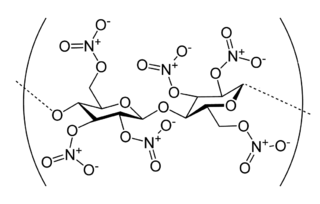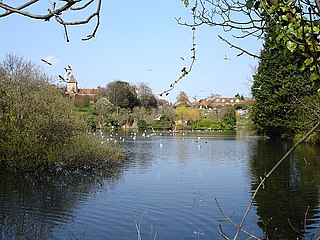Related Research Articles

Dynamite is an explosive made of nitroglycerin, sorbents, and stabilizers. It was invented by the Swedish chemist and engineer Alfred Nobel in Geesthacht, Northern Germany, and was patented in 1867. It rapidly gained wide-scale use as a more robust alternative to the traditional black powder explosives. It allows the use of nitroglycerine's favorable explosive properties while greatly reducing its risk of accidental detonation.

Nitrocellulose is a highly flammable compound formed by nitrating cellulose through exposure to a mixture of nitric acid and sulfuric acid. One of its first major uses was as guncotton, a replacement for gunpowder as propellant in firearms. It was also used to replace gunpowder as a low-order explosive in mining and other applications. In the form of collodion it was also a critical component in an early photographic emulsion, the use of which revolutionized photography in the 1860s.

On the morning of 6 December 1917 the French cargo ship SS Mont-Blanc collided with the Norwegian vessel SS Imo in the harbour of Halifax, Nova Scotia, Canada. The Mont-Blanc, laden with high explosives, caught fire and exploded, devastating the Richmond district of Halifax. At least 1,782 people were killed, largely in Halifax and Dartmouth, by the blast, debris, fires, or collapsed buildings, and an estimated 9,000 others were injured. The blast was the largest human-made explosion at the time. It released the equivalent energy of roughly 2.9 kilotons of TNT (12 TJ).

Boylston station is a light rail station on the MBTA Green Line in downtown Boston, Massachusetts, located on the southeast corner of Boston Common at the intersection of Boylston Street and Tremont Street. A southbound street-level stop for the SL5 route of the bus rapid transit Silver Line is outside fare control. The station has two island platforms; each has one disused track, making them effectively side platforms. Boylston is not accessible for Green Line trains.

Faversham, in Kent, England, has claims to be the cradle of the UK's explosives industry: it was also to become one of its main centres. The first gunpowder plant in the UK was established in the 16th century, possibly at the instigation of the abbey at Faversham. With their estates and endowments, monasteries were keen to invest in promising technology.

River Works station is an MBTA Commuter Rail station on the Newburyport/Rockport Line in West Lynn, Massachusetts. The only private station on the system, it is only open to GE Aviation employees who work at the adjacent River Works plant. The station has minimal facilities – two small sections of platform and several shelters – and is not accessible.

The 1924 Nixon Nitration Works disaster was an explosion and fire that claimed many lives and destroyed several square miles of New Jersey factories. It began on March 1, 1924, about 11:15 a.m., when an explosion destroyed a building in Nixon, New Jersey used for processing ammonium nitrate. The explosion touched off fires in surrounding buildings in the Nixon Nitration Works that contained other highly flammable materials. The disaster killed twenty people, destroyed forty buildings, and demolished the "tiny industrial town of Nixon, New Jersey."
The following is a timeline of the history of Lynn, Massachusetts, USA.
The Aleppo University bombings took place on 15 January 2013, during the Syrian Civil War. The bombings killed at least 87 people at the Aleppo University, including students and children. The explosions reportedly struck an area between the University of Aleppo's halls of residence and the faculty of architecture, on the first day of exams. Both sides blamed each other for the explosions. While the university has been a center of antigovernment demonstrations, it is also in a government-held area, with neither side seemingly having had an obvious reason to strike. It was also a refuge for over 30,000 civilians fleeing the fighting in Aleppo.

The Stowmarket Guncotton Explosion happened on 11 August 1871 at the Prentices Guncotton Factory in Stowmarket, Suffolk. It was blown up by two massive explosions, that occurred within the factory, killing 28 people and injuring approximately 70 others.

The following events occurred in November 1928:

John Russell Macomber was an American financier and sportsman.

The Paramount Hotel explosion occurred on January 28, 1966, in Boston. A series of explosions under the hotel and resulting fires killed 11 people.
The United States Cartridge Company explosion occurred on July 29 1903, in present-day Lowell, Massachusetts. The explosion of two buildings used to store dynamite and gunpowder killed 22 people and destroyed 13 homes.
The Beacon Oil explosion occurred on February 10, 1928, at the company's distilling plant in Everett, Massachusetts. 14 people were killed in 36 injured in the disaster.
Beacon Oil Company was an American oil and gas corporation headquartered in Boston.
References
- ↑ "Box toe Definition & Meaning". Merriam-Webster. Merriam-Webster, Incorporated. Retrieved 23 February 2022.
- 1 2 3 4 5 6 7 8 9 "17 Lives Lost in Lynn Explosion". The Boston Daily Globe. November 9, 1928.
- 1 2 "John Coleman Dies, 20th in Lynn Blast". The Boston Daily Globe. November 25, 1928.
- ↑ "Previous Explosions In Boston". The Boston Globe. January 29, 1966.
- ↑ "17 Killed, 5 Dying in Lynn Explosion". The New York Times. November 9, 1928.
- 1 2 "Blast Toll Mounts as H. W. Blaney Dies: Father Joins Six Others of Family in Death". The Boston Daily Globe. November 22, 1928.
- ↑ "Six Blaneys, Killed in Explosion, Buried". The Boston Daily Globe. November 12, 1928.
- ↑ "Note From Coolidge for Blast Survivor". The Boston Daily Globe. November 14, 1928.
- ↑ "Mayor Bauer Urges All to Aid Blaneys". The Boston Daily Globe. November 15, 1928.
- ↑ "Cigarette Butts in Lynn Fire Ruins". The Boston Daily Globe. November 10, 1928.
- ↑ "19th Victim Dead in Lynn Explosion". The New York Times. November 10, 1928.
- 1 2 "Recommends Lynn Fire Dept Changes". The Boston Daily Globe. June 13, 1929.
- ↑ ""I'm Goat," Chase Says After Inquest". The Boston Daily Globe. January 18, 1929.
- ↑ "Double Indemnity Denied Employes". The Boston Daily Globe. September 26, 1929.